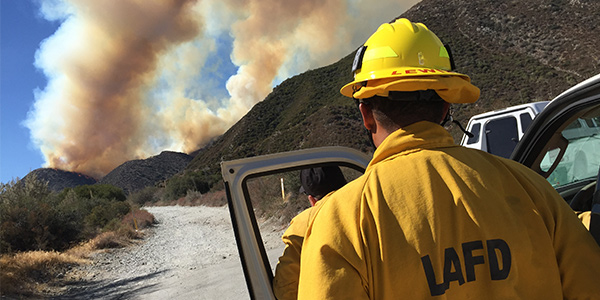By Rich Heidorn Jr.
NERC is accepting comments until Nov. 4 on the second draft of a revised standard to improve the ride-through performance of inverter-based resources (PRC-024-3: Frequency and Voltage Protection Settings for Generating Resources).
The standard is intended to address issues identified in the Inverter-Based Resource Performance Task Force’s PRC-024-2 Gaps Whitepaper, which was prompted by the August 2016 Blue Cut wildfire, when 1,200 MW of solar generation disconnected, and the October 2017 Canyon 2 fire, which resulted in the loss of more than 900 MW.
The 45-day comment period opened Sept. 20 after a Sept. 4 webinar, at which the standard drafting team (SDT) explained changes made in response to industry comments on the initial draft. (See Comments due July 26 on Revised Inverter Standard.)
Draft 2 increases the implementation plan to 24 months from the original 18 months, which was criticized as too short.
Definitions
The term “point of interconnection” — which the current standard defines as the “the transmission (high voltage) side of the generator step-up (GSU) or collector transformer” — was eliminated.
The original term “meant so many different things to different entities,” explained SDT Chair Bryan Burch, of Southern Co.
“What a lot of folks call the point of interconnection in industry is actually not the high side of the GSU,” added Vice Chair Jeff Billo, of ERCOT.
The new draft also replaces the term “momentary cessation” with “cease to inject current.”
“The team talked about that with the inverter industry and … we came to the conclusion that the best path was to eliminate the use of the term ‘momentary cessation’ and go instead with the term ‘cease to inject current’ to better specify the intent and be more uniformly understood,” said team member John Anderson, of Xcel Energy.
The standard also replaces the term “protective relays” with “protection” to include both relays and protective functions embedded in control systems.
No-trip Zone
The team also eliminated the label “may-trip zone” from illustrations in the standard.
“There were comments made that we were then encouraging people to set their protection to trip before there were any machine requirements requiring that trip,” Anderson said. “As a response, the drafting team has eliminated these ‘may-trip zone’ labels on our curves and instead specified with a footnote that the area outside the no-trip zone is not a must -trip zone — hopefully to eliminate encouraging people to set their relay to prematurely trip.”
“The true intent, which is not enforceable on our end, is that we don’t want the protection to encroach on that boundary,” Burch said.
The team declined requests to specify what voltage protection settings should be beyond four seconds after a fault, saying anything after four seconds was outside the scope of the standard.
“We did a lot of research on this — looking back at what went into the original PRC-024-1 determination — and we pretty much found that this whole purpose of this standard was to define these frequency and voltage excursions that might be experienced during and after the clearing of a fault,” Anderson explained. “And we pretty much came to the conclusion that we didn’t have any basis to change that four seconds from the determination that was originally applied in PRC-024-1.”
Conflict with PRC-005-6?
The team was asked whether the standard would cover control systems such as automatic voltage regulators (AVRs) and, if so, how the initiative would mesh with a separate one to revise PRC-005-6. That standard authorization request says the standard needs clarification so that industry can “consistently identify and implement the required maintenance activities” on AVRs.
Anderson said PRC-024 would cover AVRs. “If it causes tripping of the generator either directly [or indirectly], then it is in scope,” he said.
“We can’t really commit to what the PRC-05 SAR and drafting team will do. We can specify that AVRs’ trips on voltage frequency and volts per hertz are in scope for PRC-024. PRC-05 might have other field-over-current-type functions that aren’t applicable to PRC-024,” he continued. “PRC-05 also deals with maintenance of those components, and we’re just dealing with the settings. So, there’s certainly some potential for misalignment. But since PRC-024 is focused on voltage and frequency — volts-per-hertz-type settings — potentially there will be some commonality.”
6 Questions
In its posting of draft 2, the SDT asked industry six questions, including whether the proposed changes are a cost-effective way to address the “ambiguities, inconsistencies and technical errors” in the existing standard.
The team also asked for comment on its decision not to make the standard — which covers the setting of voltage and frequency protective relays on GSU transformers and collector transformers — applicable to transmission owners in the U.S.
No TOs have been identified in the U.S. as owners of such transformers. However, the standard would apply to Hydro-Québec TransÉnergie, which owns the GSUs for about 37 GW of generation that it does not own. (See Tx Owners to be Exempt from Inverter Standard.)
The team also sought feedback on:
- its modification of the “facilities” section to clarify both the types of “protection” applicable, if activated, and the specific equipment the protection is applied on;
- exempting auxiliary equipment and associated protection(s) within a generating facility from the standard;
- replacing the 0.1-second “minimum time (sec)” value in the frequency tables with “instantaneous,” and clarification regarding frequency calculation/measurement; and
- the revised implementation plan, which would provide 24 months for applicable entities to evaluate settings, make changes for applicable equipment and purchase necessary equipment.
- An additional 10-day ballot for the standard and a nonbinding poll of the violation risk factors and violation severity levels is expected Oct. 25 to Nov. 4.
NERC board adoption is targeted for February 2020.





